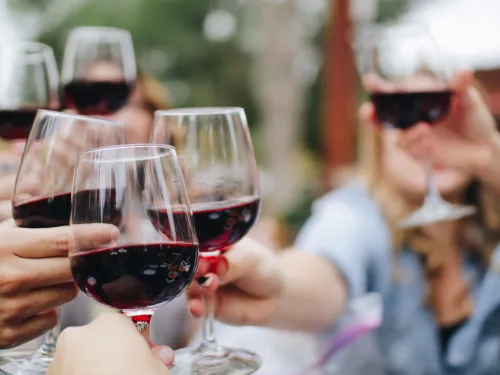Let your taste buds tell you. Tasting wine for beginners.
Joanne Elves
If I shut my eyes during a wine tasting, I am absolutely useless at telling if it’s a white or a red. Honestly, I’m that bad. If I remember that white wine is usually chilled, that does help. Since I am off to a few events this summer that are awash in wine, it might be a good idea to learn a few tips to not look so lost. Here’s what I’ve learned.
First, a wine tasting is for educating yourself not for getting drunk. Drinking too much during a wine tasting will confuse your taste buds. Go slow and savour the flavours and the experience.
Looking for even more Zen inspiration? Subscribe to our YouTube channel
Colour is more than just red and white
Seeing red and white is the easy part but going into the colours as they pertain to the grapes, the processing or the aging takes a keen eye. By looking straight down into a glass of red, you are looking at the darkest spot. Hold the glass to the light. Dark or saturated purple colours suggest a Syrah or a Malbec. Ruby red will be a Cabernet Sauvignon. A lighter shade bordering on a copper colour may suggest a Pinot Noir. Holding a white wine up to the light may show it to be a crisp yellow - maybe a Riesling. If it’s gold like a faded leaf in the fall, maybe its a chardonnay.
Swirl like a pro
You’ve seen the wine pros hold the glass up and give it a gentle swirl to introduce some air. You should do that too. It gives the aromas a chance to escape. As you stop swirling the wine will form “legs” or “tears” as it sinks back to the bottom of the glass. Thick legs means more alcohol and bigger flavours.
As you swirl, learn a bit about the wine from the person pouring. Sometimes it’s a wine rep but many smaller wineries are represented by the owners or their families. Listen to the story behind the wine, the name and even the label. You’ll get bonus points from your friends when you have insider knowledge!
Sniff but don’t snort
After the wine has settled from a swirl, let the aroma come to you. Yes, let your nose hover over the rim but don’t bury it for a snort. Gently draw in the scents. Try to single out the flavours before the wine host tells you what to smell. Are you smelling blackberry, raspberry, cherry? The smell of those berries is actually a combination of the grapes, the oak and the steel of the barrels they rested in.
Ask yourself if its sweet like fruit? Does it taste like it should go with a steak because it’s spicy? Does it feel buttery, or taste like coffee or chocolate?
Finally sip it
Have you seen people slurp wine like they are sucking on a straw? It’s all about bringing air in with the wine to bring out more of the flavours. It’s not easy to do without sounding silly. I did this and ended up choking on the wine that splashed to the back of my throat.
As the wine swirls in your mouth, are the flavours balanced or is something jumping up and down on your tonsils? Is it too sweet or to sour for your liking? If you say yum, then there is a good balance for you. If you feel like you just bit a tree, maybe there was too much aging in an oak barrel for your liking.
Are the flavours obvious. Can you instantly say, “Oh, that tastes like a crisp apple.” Or are the flavours complex like you’ll find in older red wines. Do you stand there gazing into space while your taste buds read the history of the wine? A flavourful robust wine will excite all of your taste buds at the tip of your tongue, the middle of your mouth and just before you swallow. Tasting wine should be slow. Let your taste buds tell you a story.
Swallow or spit?
If you are like me, spitting anything ends up on my chin. So, I take a small sip to see if I even like it. If I like it, I’ll repeat the process a few times then toss the rest into the silver bucket and move on to the next wine. If you are at a wine tasting event, take notes or at least pictures with a thumbs up or down in front of the bottle. If the pictures show you wearing a lampshade while spilling red wine on your host…you didn’t do it right.
Like Our Facebook Page



